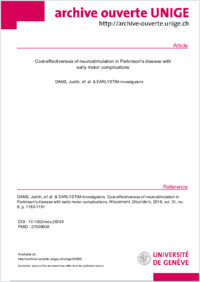Cost-effectiveness of neurostimulation in Parkinson's disease with early motor complications.
- Dams J Department of Neurology, Philipps-University Marburg, Marburg, Germany.
- Balzer-Geldsetzer M Department of Neurology, Philipps-University Marburg, Marburg, Germany.
- Siebert U Department of Public Health, Health Services Research and HealthTechnology Assessment, UMIT-University for Health Sciences, Medical Informatics and Technology, Hall i.T., Austria.
- Deuschl G Department of Neurology, Christian-Albrechts-University Kiel, Kiel, Germany.
- Schuepbach WM Assistance-Publique Hôpitaux de Paris; Centre d'Investigation Clinique 9503, Institut du Cerveau et de la Moelle épinière; Département de Neurologie, Université Pierre et Marie Curie-Paris 6 et INSERM, CHU Pitié-Salpêtrière, Paris, France, and Movement Disorders Center, Department of Neurology, Bern University Hospital and University of Bern, Bern, Switzerland.
- Krack P Department of Neurology, University Hospital INSERM Unite 836, Grenoble Alpes University, Saint-Martin-d'Hères, France.
- Timmermann L Department of Neurology, University Hospital Cologne, Cologne, Germany.
- Schnitzler A Institute of Clinical Neuroscience and Medical Psychology, Heinrich-Heine University Duesseldorf, Duesseldorf, Germany.
- Reese JP Department of Medical Sociology and Social Medicine, Philipps-University Marburg, Marburg, Germany.
- Dodel R Department of Neurology, Philipps-University Marburg, Marburg, Germany.
- 2016-08-11
Published in:
- Movement disorders : official journal of the Movement Disorder Society. - 2016
Markov model
cost-utility analysis
deep brain stimulation
dyskinesia
early Parkinson's disease
Adult
Antiparkinson Agents
Cost-Benefit Analysis
Deep Brain Stimulation
Female
Germany
Humans
Male
Middle Aged
Outcome Assessment, Health Care
Parkinson Disease
Quality of Life
Subthalamic Nucleus
English
BACKGROUND
Recent research efforts have focused on the effects of deep brain stimulation of the subthalamic nucleus (STN DBS) for selected patients with mild-to-moderate PD experiencing motor complications.
OBJECTIVES
We assessed the cost utility of subthalamic DBS compared with the best medical treatment for German patients below the age of 61 with early motor complications of PD.
METHODS
We applied a previously published Markov model that integrated health utilities based on EuroQoL and direct costs over patients' lifetime adjusted to the German health care payer perspective (year of costing: 2013). Effectiveness was evaluated using the Parkinson's Disease Questionnaire 39 summary index. We performed sensitivity analyses to assess uncertainty.
RESULTS
In the base-case analysis, the incremental cost-utility ratio for STN DBS compared to best medical treatment was 22,700 Euros per quality-adjusted life year gained. The time to, and costs for, battery exchange had a major effect on the incremental cost-utility ratios, but never exceeded a threshold of 50,000 Euros per quality-adjusted life year.
CONCLUSIONS
Our decision analysis supports the fact that STN DBS at earlier stages of the disease is cost-effective in patients below the age of 61 when compared with the best medical treatment in the German health care system. This finding was supported by detailed sensitivity analyses reporting robust results. Whereas the EARLYSTIM study has shown STN DBS to be superior to medical therapy with respect to quality of life for patients with early motor complications, this further analysis has shown its cost-effectiveness. © 2016 International Parkinson and Movement Disorder Society.
Recent research efforts have focused on the effects of deep brain stimulation of the subthalamic nucleus (STN DBS) for selected patients with mild-to-moderate PD experiencing motor complications.
OBJECTIVES
We assessed the cost utility of subthalamic DBS compared with the best medical treatment for German patients below the age of 61 with early motor complications of PD.
METHODS
We applied a previously published Markov model that integrated health utilities based on EuroQoL and direct costs over patients' lifetime adjusted to the German health care payer perspective (year of costing: 2013). Effectiveness was evaluated using the Parkinson's Disease Questionnaire 39 summary index. We performed sensitivity analyses to assess uncertainty.
RESULTS
In the base-case analysis, the incremental cost-utility ratio for STN DBS compared to best medical treatment was 22,700 Euros per quality-adjusted life year gained. The time to, and costs for, battery exchange had a major effect on the incremental cost-utility ratios, but never exceeded a threshold of 50,000 Euros per quality-adjusted life year.
CONCLUSIONS
Our decision analysis supports the fact that STN DBS at earlier stages of the disease is cost-effective in patients below the age of 61 when compared with the best medical treatment in the German health care system. This finding was supported by detailed sensitivity analyses reporting robust results. Whereas the EARLYSTIM study has shown STN DBS to be superior to medical therapy with respect to quality of life for patients with early motor complications, this further analysis has shown its cost-effectiveness. © 2016 International Parkinson and Movement Disorder Society.
- Language
-
- English
- Open access status
- green
- Identifiers
-
- DOI 10.1002/mds.26740
- PMID 27506638
- Persistent URL
- https://folia.unifr.ch/global/documents/173362
Statistics
Document views: 13
File downloads:
- fulltext.pdf: 0
